|
|
|
Sort Order |
|
|
|
Items / Page
|
|
|
|
|
|
|
| Srl | Item |
| 1 |
ID:
130973
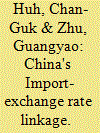

|
|
|
|
|
| Publication |
2014.
|
| Summary/Abstract |
This paper examines how the China-bound exports of Japan and Korea are related to exchange rates, motivated by the fact that processing trade makes up a large proportion of China's trade, and that Japan and Korea are the leading source countries for processing imports. Because processing imports are inputs for exports, the link between such imports and China's exchange rates are ambiguous. We estimate export functions that include China's RMB real effective exchange rates (REER) along with bilateral real exchange rates (BRER) using Johansen's cointegration method and find that the RMB REER significantly affects Japanese and Korean exports to China, even more so than BRER in most cases examined. These two exchange rates appear in the export equations with opposite signs. Subsequently, we use the estimated model to illustrate the importance of accounting for a concurrent change in BRER when analyzing the effects of a hypothetical RMB revaluation on China's trade balances despite the apparently weak imports-BRER linkage.
|
|
|
|
|
|
|
|
|
|
|
|
|
|
|
|
| 2 |
ID:
130972
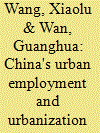

|
|
|
|
|
| Publication |
2014.
|
| Summary/Abstract |
The present paper argues that China's existing population and employment statistics are misleading, and have failed to include many of the migrant and labor force flows between urban and rural areas. The paper reconciles the differences between official census data and other survey statistics and attempts to recalculate China's urban population and employment figures. Our analyses indicate that official statistics of 2012 underestimate China's urban employment by approximately 47 million while overestimating rural employment by 31 million. The adjusted urbanization rate exceeded 55 percent in 2012, almost 3 percentage points higher than the official statistics. Nevertheless, there remains much potential for rural-to-urban migration. More specifically, if the current bottlenecks in household registration, social security and public welfare systems can be removed or relaxed, China's urbanization rate could rise by another 10 percentage points or even more over the next decade.
|
|
|
|
|
|
|
|
|
|
|
|
|
|
|
|
| 3 |
ID:
130974
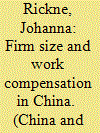

|
|
|
|
|
| Publication |
2014.
|
| Summary/Abstract |
Remarkably, recent research on the Chinese labor market has suggested that the situation in China is inconsistent with the stylized fact that large firms pay higher wages and offer more generous benefits. Expanding the empirical basis from 78 to 300 000 industrial firms, I overturn the previous result and show that wage determination in the average firm fits the international norm. Exploring subsamples of firms I also point to a likely source for the conflicting findings: firm size is positively correlated with the average wage in private firms, but negatively correlated with the average wage in the state-owned sector. These novel results could guide future studies aiming to understand the sources of the firm size wage premium, and, in particular, studies that target the largest industrial labor market in the world.
|
|
|
|
|
|
|
|
|
|
|
|
|
|
|
|
| 4 |
ID:
130971
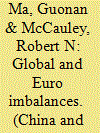

|
|
|
|
|
| Publication |
2014.
|
| Summary/Abstract |
We analyze global and euro area imbalances by focusing on China and Germany as large surplus and creditor countries. In the 2000s, domestic reforms expanded the effective labor force, restrained wages, shifted income toward profits and increased corporate saving. As a result, the Chinese and German current account surpluses widened, and that of Germany has proven more persistent, with subdued domestic investment. China is an early-stage creditor, holding a short equity position and a long position in safe debt. Germany's balanced net debt and equity claims mark it as a mature creditor that provides insurance to the rest of the world. China pays to lay off equity risk, while Germany, by contrast, harvests a moderate yield on its net claims. In both economies, the shortfall of the net international investment position from cumulated current account surpluses arises from exchange rate changes, asymmetric valuation gains, and, in Germany's case, credit losses.
|
|
|
|
|
|
|
|
|
|
|
|
|
|
|
|
| 5 |
ID:
130975


|
|
|
|
|
| Publication |
2014.
|
| Summary/Abstract |
The present paper investigates how neighborhood effects are connected to chronic poverty. We examine a large sample of groups of households and find that neighborhood effects are significant in a majority of groups, especially in the poorest groups. People living in poor communities tend to suffer from poverty over time. It is of theoretical and empirical importance to explore how neighborhood effects are interrelated with chronic poverty and the channels through which this occurs. Unlike other econometric analyses, we establish a multilevel econometric model to show that: (i) it is difficult for an individual living in a neighborhood with a high proportion of agricultural labor, low education levels, and poor transport and telecommunication infrastructure to escape from poverty traps; (ii) neighborhood effects dominate in poor communities; and (iii) although poverty is affected by group-level factors, individual factors still play a dominant role in regards to escaping poverty when income surpasses a threshold level. Therefore, policy priority should be given to providing social protection and public services, especially in poor rural areas
|
|
|
|
|
|
|
|
|
|
|
|
|
|
|
|
| 6 |
ID:
130976
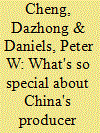

|
|
|
|
|
| Publication |
2014.
|
| Summary/Abstract |
In the present study, five stylized facts about China's producer services are established through international, intersectoral and intertemporal comparisons based on input-output tables. First, the overall service input ratio is the lowest in all the sample economies. Second, most producer services are supplied by the traditional labor-intensive sectors. Third, manufacturing is the biggest user of producer services, and service industry is the second, while the opposite is true for most of the other sample economies. Fourth, unlike other economies, China's "R&D" is characterized more by consumer services than producer services. Fifth, China has fairly lower service input ratios in almost all the industries. The backward and forward linkages coefficients are both smaller for "real estate activities" and "finance and insurance." Policy reform should focus not only on specific producer services but also on reducing obstacles that are inhibiting the balanced development of diverse producer services that will help China to optimize its economic structure.
|
|
|
|
|
|
|
|
|
|
|
|
|
|
|
|
|
|
|
|
|